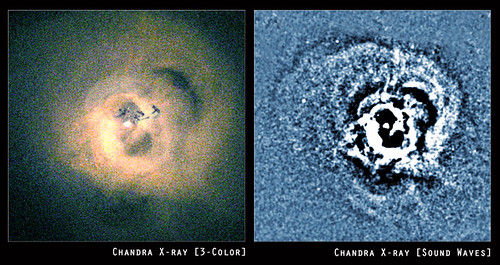Can You Hear a Black Hole?
- By Maggie Masetti
- October 29, 2013
- Comments Off on Can You Hear a Black Hole?
Recently I came across this story – this ten year old story – on Tumblr.
Sept. 9, 2003: Astronomers using NASA’s Chandra X-ray Observatory have found, for the first time, sound waves from a supermassive black hole. The “note” is the deepest ever detected from any object in our Universe. The tremendous amounts of energy carried by these sound waves may solve a longstanding problem in astrophysics.
The black hole resides in the Perseus cluster of galaxies located 250 million light years from Earth. In 2002, astronomers obtained a deep Chandra observation that shows ripples in the gas filling the cluster. These ripples are evidence for sound waves that have traveled hundreds of thousands of light years away from the cluster’s central black hole.
“The Perseus sound waves are much more than just an interesting form of black hole acoustics,” says Steve Allen, of the Institute of Astronomy and a co-investigator in the research. “These sound waves may be the key in figuring out how galaxy clusters, the largest structures in the Universe, grow.”
Here is the story on Chandra’s website.

Chandra’s 53-hour observation of the central region of the Perseus galaxy cluster (left) has revealed wavelike features (right) that appear to be sound waves. Credit: NASA/CXC/IoA/A.Fabian et al.
Why this subject, albeit with an embedded audio joke, was making the rounds on Tumblr now, I don’t know. But what struck me was the comments on the post calling shenanigans – because if light can’t escape a black hole, then how can sound?
The answer is, you can “hear” black holes the same way you can “see” them – indirectly. Because it is true that nothing can escape a black hole – but that is only true of matter that crosses the event horizon, the gravitational point of no return. Black holes can and do affect their environments in detectible ways.
Despite what the “Impossible Planet” episode of Doctor Who will tell you, it is perfectly possible for something to orbit a black hole. In fact, one way we detect stellar-mass black holes is when they are part of a binary star system. The black hole’s effects on the companion star are observable by us here on Earth – effects like a black hole slowly cannibalizing its companion.
Gas from the companion star can get pulled towards the black hole, which then spirals around the black hole. This disk (called an accretion disk) gets super, super hot, so hot that it releases X-rays. We can see these X-rays even if we can’t see the black hole itself.
But not only stellar-mass black holes have accretion disks. Supermassive black holes, those at the center of galaxies, also have them. Their accretion disks are acquired from the interstellar gas which abounds in the nuclei of galaxies.
Accretion disks are weird things – not surprising considering they exist at extreme conditions. For example, occasionally the inner portion of the accretion disk will just blow! When this happens we can observe jets of high-energy particles blasting out from the black hole, at opposite sides of a single point, originating from the region of the event horizon. There, these jets are fueled by strong magnetic fields.
As it turns out, according to Steve Allen, from the Institute of Astronomy in Cambridge, it is indeed the jets that are causing the sound waves to emanate from the black hole. How? Well, these jets are so powerful that they actually compress the surrounding gas, carving out cavities. The energy from the jets excites sound waves (which are essentially pressure waves) that spread out from these cavities, which then crash into the gas, transferring their energy as heat. The heating of the gas creates X-rays, and these are what was detected by the Chandra X-ray observatory.
Interestingly, the X-rays emitted actually match the cycle of the sound waves. “In effect,” said Andy Fabian (also from the Institute of Astronomy), “The sound waves cause bright and dark emissions of X-rays moving in rings away from the black hole center like ripples on the surface of a pool.” So if we can measure the distance between the waves, we can determine the ‘pitch” of the black hole.
Human ears can only hear sound waves that are close together and cycle very rapidly, so the sounds of this black hole are not something the human ear could detect. There are apparently 10 million years between each of the sound waves! Curious what key the black hole is in? It’s B flat – but 57 octaves below the B flat next to middle C. “This is a tone frequency more than a million, billion times deeper than the limits of the human ear,” said Fabian.
Besides being really poetic and cool (the universe is musical!), this discovery may actually explain a few things. Astronomers have long been trying to figure out why there is so much hot gas in galaxy clusters. The gas should eventually be cooling off – but it’s not. So what is heating the gas? It could very well be these sound waves.
As an addendum, there are other ways to “hear” black holes. This isn’t the same physical phenomena as what was detected by Chandra, but Edward Morgan of MIT took X-ray data from the black hole GRS 1915+105, and translated it into audio signals, allowing us to listen to this object actually throw off its accretion disk. You can hear low frequency static (the X-ray background), skips or lub-dubs which are the X-ray/infrared (but not the super luminal) jets escaping from the accretion disk, and high-pitched whistles of escaping X-rays. Read more at the Rossi X-ray Timing Explorer Learning Center
More reading:


